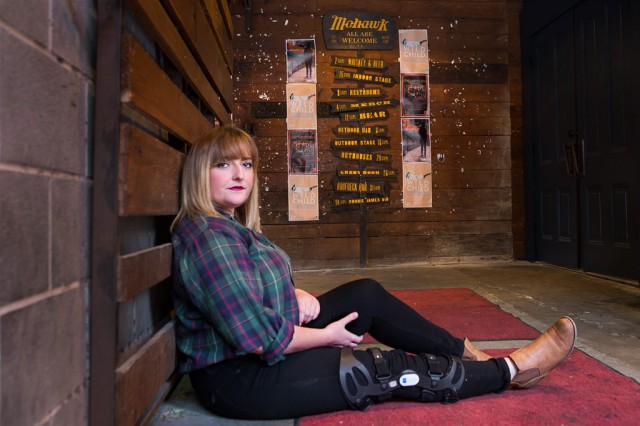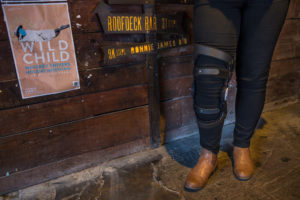Time Is Running Out for Promised Safety Measures at South by Southwest

Mason Endres recently returned to The Mohawk music venue in downtown Austin. Endres was in line outside the venue during the 2014 South by Southwest festival when a car jumped a barricade and crashed into a crowd of festival-goers. Photos by Rocio Tueme/Reporting Texas
By Darby Kendall
For Reporting Texas
It is a night that forever changed Mason Endres, even though she can barely remember it.
“I can tell you just what my friends told me,” Endres said about the early hours of March 13, 2014, when she was run over by a drunk driver while waiting outside a club during Austin’s South by Southwest festival. “We were down in front of the Mohawk to see Tyler the Creator, and my friends and I were standing in the road when, right at 12:30, a car just came blowing through. Then my friends looked up and realized I was gone.”
Twenty-four people were injured on Red River Steet. Endres, 19, of Liberty Hill, was in a hospital for three weeks. After knee surgery, she was in a wheelchair for four months and on crutches for another two. She began classes a semester late, in January, at the University of Texas at Austin, where she studies public relations, and finished physical therapy a month ago.
Still, she got lucky. Four people died from the mayhem.
In its aftermath, the Austin City Council promised a series of security improvements during the music, film and digital media festival that draws tens of thousands of people to the city each year. These included requiring businesses to buy liability insurance to protect against damage caused by drunk customers for events on public property, and attempting to quantify and then enforce an acceptable “occupant load” for the downtown area.

A year later, Endres still wears a leg brace.
With this year’s festival less than a month away, though, changes once described by Assistant Police Chief Jason Dusterhoft as measures to “make this one of the safest Southby’s ever” are still works in progress for the most part — and time is running out.
“Most of these proposals are either unrealistic or will have no meaningful impact, or both,” said Michael Levy, vice chairman of the Austin Public Safety Commission, which advises the City Council on public safety issues.
Levy said many of the proposals were put forth after the accident because city officials wanted to quickly establish that there were new plans to create a safer festival. Moving from idea to implementation has been slower than anticipated.
“I wish it was a perfect world and the proposals could go through quickly,” said William Manno, the city’s corporate special events program manager.
Wholesales changes in Austin’s political leadership delayed the process, he said. Mayor Steve Adler and nine of the 10 council members were elected in the fall and took office in January. “The ordinance is still being worked on,” Manno said. “The city wanted to wait until the new council got into place, and then start fresh with them. I doubt it will be presented before South by Southwest of this year. I’m hoping to get it in front of council again by May.”
After the accident, the city’s urgency to propose new measures might have led to some unrealistic ideas. For one, enforcing an acceptable occupancy load in the downtown area is nearly impossible, Manno said.
Safety concerns shoot up during South by Southwest, which will run from March 13 to 22. Last year, police made 328 intoxication-related arrests citywide, including 63 downtown, according to a lawsuit filed against SXSW Holdings Inc. Melees have broken out at times and crowds have torn down barricades to get into venues.
The city has made one significant change to help control the crowds, reducing the number of temporary event permits from 168 at last year’s festival to 114.
“We review every permit that comes in based on how big the event is, where it is and who is playing at the event,” said Cmdr. Timothy Pruett of the Austin Police Department. “We take a look when we get to a certain point and decide if we have too many events and do we have the resources to cover this amount of events. All of our resources in the city are stretched out during South by Southwest.”
Police will be on the lookout for overflowing lines at large venues. If a crowd appears to be disorderly while in line, the business could have its temporary permit revoked, according to Manno.
Levy worries that “the neighborhoods are paying a price for the city’s reaction to SXSW,” predicting slower than normal police response times outside of downtown.
Pruett said that won’t be an issue.
“We’re not taking patrol officers away from their patrolling different parts of town, and we’re not going to pull a whole unit off of the streets,” he said. “We’re mitigating the amount of officers we pull every day by pulling on-duty officers from different units at different times, so those units can continue to work.”
Attorney Scott Hendler, who filed the suit on behalf of families of those who died in last year’s accident, blamed both the city and SXSW management for poor safety planning.
“I think the city has depended on South by Southwest to adopt appropriate measures, and South by Southwest planners have thus far been inept when it comes to safety planning for this event,” Hendler said.
A SXSW representative declined to comment.
Endres, finally walking again, blamed her injuries on the drunk driver, who faces felony charges including capital murder. She said she will be back at the festival this year.
“Music and live music are what I love,” she said. “South by Southwest is something that I would never dream about missing since it’s right here where I live.”